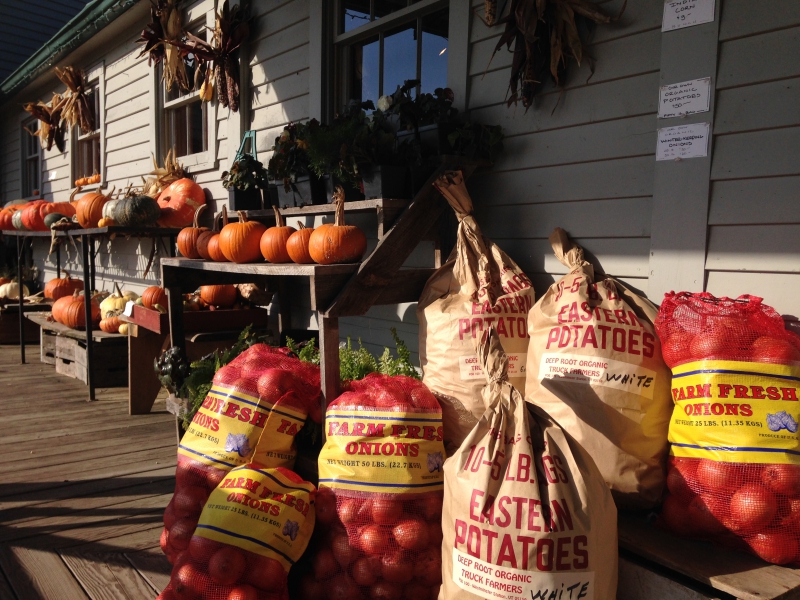By Allyson Wendt
There’s a touch of frost on the fields as I arrive at Harlow Farm in Westminster on an early November morning. After a long, warm fall, winter is definitely coming. I head for the relative warmth of the big barn, where I find farm manager Jon Slason and his crew trimming turnips for packing and delivery.
I’m here to see the storage methods Harlow Farm uses for its winter veggies. With around 2,000 square feet of cold storage on site and another 2,000 rented from Black River Produce in Springfield, the farm has the largest facilities in the southern part of the state (Pete’s Greens in Craftsbury has the most up North).
The cold storage facilities at Harlow were built in 2000 to allow the farm to expand in a sustainable way. “We could have found new markets to sell more fall produce and continue to shut down for the winter,” explains Slason. “But we wanted to find a way to employ people year-round. So we went for cold storage.” The farm employees around 18 people throughout the winter, and supplies storage crops like beets, turnips, carrots, cabbages, squash, and onions to local markets and restaurants.
Keeping produce through the winter without spoilage involves a lot of science. Each vegetable, explains Slason, has a perfect combination of temperature and humidity that will keep it fresh. For thin-skinned crops like beets and carrots, that combination is around 97% humidity and 33 degrees. To maintain these conditions, crops are kept in bins in an insulated cold room. The chillers drain to the floor, which remains wet to maintain high humidity. (It is cleaned regularly for food safety purposes.) Vegetables are stored unwashed, because the dirt helps keep them from rotting; they are cleaned before being sent to stores and restaurants.
Replicating these conditions at home is nearly impossible, unless you have a refrigerator that can maintain high humidity and can be dedicated to crop storage. And you’ll never have a gadget like the one Harlow Farm is testing, thanks to a University of Vermont Extension pilot program. A pair of sensors in the cold storage space at the farm texts and emails Slason if the temperature gets too warm or the humidity strays too far from optimal. That’s particularly important in the summer, when it can be difficult to keep up with the heat and the cold storage is used to keep delicate lettuces and other produce from wilting.
Hard-skinned vegetables like winter squash and pumpkins are easier to store at home, because they require 60% humidity and temperatures between 50 and 60 degrees. A cool bedroom, basement, or closet all work well. Butternut squash and pie pumpkins keep well, as do Kabocha squash. Use any squash with surface damage first to avoid rotting. At the farm, these crops, along with onions, are kept in the barn, where temperatures stay fairly even. It’s not ideal, Slason says, but it’s the only option right now.
Harlow Farm is looking into building a new, larger storage facility with better climate control and more space for the hard-skinned vegetables. Balancing summer and winter storage, work space, and energy efficiency is a difficult task, says Slason, who has a background in civil engineering. Winter crops are stored in high stacks, but the more delicate crops are stored in lower stacks. The farm has worked with Efficiency Vermont to optimize the performance of the current cold storage facility, and will continue to do so as the new facility is designed.
Although the farm stand at Harlow Farm shuts down during the winter (but does offers a winter-crop CSA, with a declining balance account and an online marketplace — Details here) you can find their products at several stores throughout the region as well as on restaurant menus. Slason warns that this may not be the best year for butternut squash, however, as a hail storm damaged much of the crop, limiting its storage life. If squash you have stored begins to rot, roast and freeze the puree for use in soups, pies, baked goods, and sauces.























































